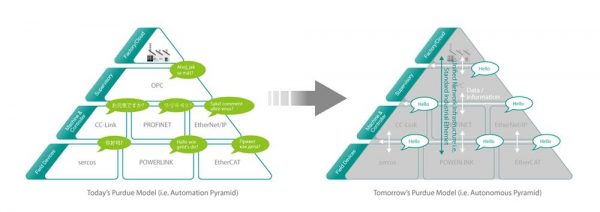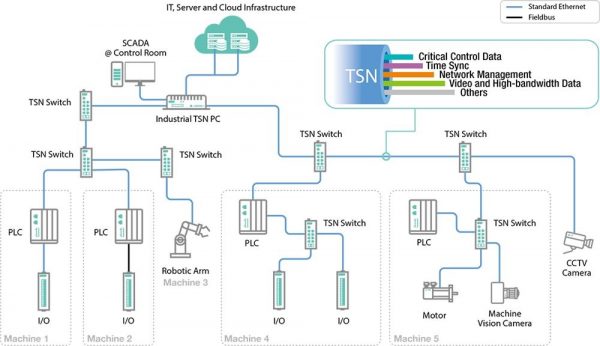Despite the fact that the COVID-19 pandemic has wreaked havoc on businesses, the Federal Reserve of the United States has predicted GDP to grow by 4.2% in 2021. The manufacturing sector is expected to play a very important role in the revival of the global economy. Seeing the light at the end of the tunnel, quite a few heavyweights in the manufacturing industry are planning to expand their production in a faster and more precise manner in response to increasing demand. However, this turnaround is going to be dependent on the willingness of companies to embrace innovative technologies that will enable them to enhance production efficiency and reduce maintenance costs. Time-sensitive networking (TSN) has been touted as a technology that can help Industry 4.0 and Industrial Internet of Things (IIoT) applications achieve high production efficiency as well as lower maintenance costs.
The industry players who have started to utilize TSN technologies have demonstrated to the world that TSN is not just an embryonic idea, but a concrete technology through multiple virtual demonstrations throughout 2020. However, before we look to the future, there are some things you should know to help you make the right investments.
What are the benefits of adopting TSN?
The two ultimate goals of TSN are the seamless incorporation of accurate and time-sensitive data into industrial processes and a detailed and holistic view of operations in order for business owners to quickly respond to market demands in real-time. By using TSN technologies, business owners can achieve the two main goals and enjoy the following benefits:
- TSN facilitates high-speed networking, large volumes of data transmission, highly accurate motion control, and low latency.
- TSN can prioritize network traffic, which guarantees real-time communication and means time-critical data will be delivered to the right place at the right time. In other words, the aim of a converged application on one unified network will be accomplished in industrial automation based on standard Ethernet. Eventually, it will be feasible to have one unified network for diversified applications. This eliminates the concern that time-critical data would not reach its destination in time.
- TSN can enhance network security because accurate data transmission can be scheduled to avoid the inflow of non-authorized data.
Diagram: One unified network for diversified applications
Is “one unified network” important?
Yes, the convergence of OT and IT networks that results in one unified network is required to facilitate accurate and coordinated data that can provide insights into production processes. However, it is extremely difficult to bring the convergence to fruition if there are gaps between the two sides, not to mention integrating isolated proprietary automation islands into OT environments. One unified network includes the following benefits:
- A single industry standard used for communication.
- Minimal training effort to understand different vendor’s protocols
- Reduced cabling and maintenance costs
What are potential applications for TSN?
Even though TSN evolved from Audio Video Bridging (AVB), the use of TSN is not restricted to audio or video applications. It is the promising features and benefits of TSN that make it indispensable to a wide range of applications that are extensively used across various industries, including semiconductor, automotive, machinery, food and drink, chemical, and power generation. However, each TSN application comes with its specific requirements, and currently there is a substantial gap between existing TSN standards and application-specific TSN systems. You can learn about how Moxa collaborated with Xilinx to make headway in developing time-sensitive networking technologies for Industry 4.0 applications.
Is it feasible for my applications to utilize TSN technologies?
You can assess if your organization should deploy TSN by reading the following statements.
If you tick off more than three statements, then TSN is an ideal solution for you.
- You experience huge costs when integrating either standard or proprietary communication technologies.
- It is very expensive to debug your existing network system due to an isolated networking structure.
- Your network system is difficult to manage and you are required to develop tools, which takes you additional time and effort.
- You have interoperability issues between your existing system and the IT system.
- You need higher network bandwidth because you want to develop an automated system.
- You have a desire to enhance your network security.
My organization is fine with the existing production processes and network setup. Why should I consider deploying TSN?
For the time being, your organization may be satisfied with production output. However, in the long term, you will find it difficult to keep up with your competitors as they embrace TSN technologies. On the one hand, you can still expand your production based on the existing infrastructure, but the expansion will be stretched to the limit when you find, for instance, the conveyor belt is communicating with the HMI by PROFINET. On the other hand, the motion control that requires hard real-time is using EtherCAT, and the robotic arm control is using another protocol, for example, Mitsubishi CC-Link IE. Even though it is comparatively easy to make use of add-on blocks as you deem necessary, managing all of these devices from different vendors who utilize different industrial Ethernet technologies is very difficult. When each cell is isolated, there are many obstacles to just integrating the data, not to mention if you want to fine tune the processes and improve production efficiency. In the long term, the result will see you moving in the opposite direction of realizing Industry 4.0 and IIoT applications. More importantly, TSN technology also allows for a plug-and-produce solution when extra applications such as machine vision and motion cameras are added onto one unified network.
Diagram: Adding more applications onto TSN’s unified network
In short, it is the convergence between IT and OT networks that enables Industry 4.0 and IIoT applications. TSN achieves this by linking up these networks, which creates significant advantages in network connectivity and reduces costs when deploying systems. Even though some people are under the misapprehension that TSN is still an unproven technology, it has actually evolved into more than just TSN switches, PLCs, servos, and IOs, to an ecosystem that helps accomplish the goals of IIoT and Industry 4.0 applications.



